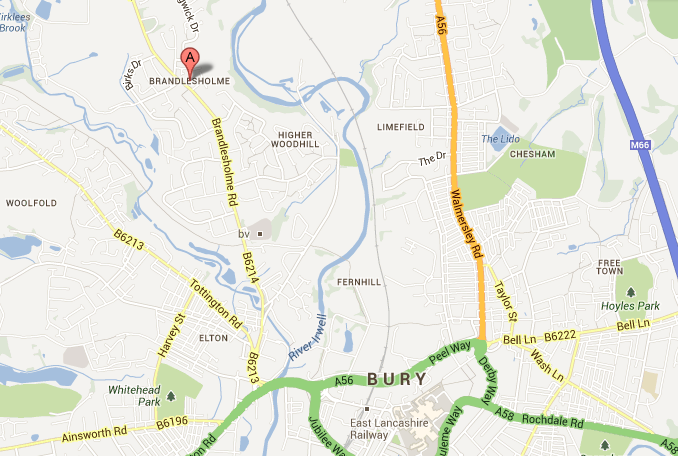The Bull of Brandlesholme (another reason to avoid Lancashire) July 10, 2013
Author: Beach Combing | in : Modern , trackbackA transcendental experience this morning in the wood: came face to face with a cow-sized wild boar that sniffed at me and then went to chew on a neighbour’s cherries. Medium-sized or large creatures in the wild often have a magical quality: foxes and deer are a particular favourite. ‘The Lords of Life’, as Lawrence called a snake in Mexico, which reminds Beach of the majesty of a rearing serpent… In any case, in celebration here is the Brandlesholme Bull, a creature that our author (Barton) thinks was factual but that, of course, might not have been. He was writing late nineteenth century and was referring to a creature that had been made into car seats a hundred years before. The bull allegedly lived on Brandlesholme Moor to the north of Bury and was as mean as an LA rapper.
A woman was gored to death by him whilst crossing the moor; several other deaths were laid to his charge; he broke the limbs of men and boys at his pleasure, and generally conducted himself in a most unwarrantable manner. Numbers of unwary ones suffered almost an equivalent to death in the terror and exhaustion of his unchecked pursuit, sometimes for a long distance, unrestrained by a fence or other impediment, and yet no word was ever suggested as to limiting his freedom. He knew his power and maintained it. His bovine majesty roamed over so large an extent of territory that the wayfarer, in passing over the moor, often knew not in which direction to anticipate his approach… Long after he was dead, the exploits of the dreaded Brandlesholme Bull occupied considerable space in many a countryman’s memory or narration.
A real sense of terror reading this. Animals following humans are always a bit unnerving. Beach remembers being frightened stupid by a flock of a hundred plus sheep trailing him across moorland as a child. Imagine though that you are fourteen and that the black bull three fenceless fields away starts to walk in your direction. Do you run, do you hide, do you arm yourself, do you pray? Are some modern myths of creatures in the British countryside bad memories of beasts like this?
Random aside: there is a black bull pub at Lowescroft about two miles (as the bull runs) from Brandlesholme: is this cobblers born of a pub, a pub born of cobblers, or a genuine memory of a nasty gorer c. 1780: drbeachcombing AT yahoo DOT com
11 July 2013: The Count is determined to pour cold water on this and (having thought about it) rightly so: Concerning the legendary Brandlesholme Bull, firstly, I doubt whether the presence of a nearby pub called the Black Bull is relevant. According to one very casual survey of popular pub names, it ranks 49th with at least 103 examples in the UK, though it’s number one in some parts of Lancashire. And if you include any reference to bulls in pub names – the Bull’s Head, for example – they’re very common throughout Britain, and ridiculously common in cattle country, such as Lancashire. Secondly, this story sounds a bit apocryphal to me. Writing a century after the fact, Barton states that it definitely killed one woman, allegedly killed several other unspecified persons, and freely roamed the moor maiming and terrifying numerous people for quite some time. English law both past and present is so torturous to google that I soon gave up trying, but surely in the late 1700s the bull’s owner would have been legally responsible for its actions, and would have been legally obliged to get rid of it as soon as it became a danger to human life, even if he didn’t feel any moral duty to do so? And if it was running wild and nobody would admit to owning it, how hard would it be to hunt down a huge animal that goes out of its way not to avoid people? A more plausible sequence of events is that the bull was well known for being aggressive, and had caused a lot of fear and maybe a few injuries, but when it actually killed somebody, it was promptly made into – well, c. 1780, probably not car-seats. Maybe leather aprons for trainee apocryphal London serial killers? And in the following century, the tale grew in the telling.’ Thanks Count!




